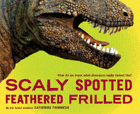
Sibert-winning author Catherine Thimmesh (Team Moon) takes a brilliant and fresh approach to dinosaurs--through the viewpoints of the paleoartists who paint their portraits.
"Recreating dinosaurs is like putting together a three-dimensional jigsaw puzzle--with plenty of pieces missing," the author writes. When a dinosaur bone is discovered, paleontologists, geologists and paleobotanists working together ask themselves a series of questions: What kind of dinosaur is it? How old are the fossils? What did the dinosaur eat? Thimmesh explains, "Finally, the paleoartists (who are often scientists as well) attempt to create an image." One spread pairs a 1901 painting of Triceratops by Charles R. Knight with another by Mark Hallett painted nearly 100 years later. Thimmesh ticks off four major differences in scientists' understanding of dinosaurs in the intervening century. John Sibbick's color series of Parasaurolophus demonstrates the challenge of determining a dinosaur's outer markings ("Color is a real problem," Sibbick said).
With reproductions of the paleoartists' paintings and sculptures, Thimmesh's unusual approach allows her to discuss the history of dinosaur research. For instance, after a "virtual standstill" during the Great Depression and World War II, "dinosaur science came roaring back" with a "seismic shakeup," mostly thanks to John Ostrom's 1964 discovery of Deinonychus, which supported the theory that dinosaurs were warm-blooded. Stephen Czerkas describes the move from scales to feathers on the model he created with Sylvia Czerkas for Deinonychus saying, "You have to change what you think in the face of new scientific evidence." This book will be a hit among dinosaur lovers and budding scientists alike. --Jennifer M. Brown, children's editor, Shelf Awareness

